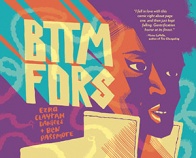In his follow-up to the decorated “Upgrade Soul,” Ezra Claytan Daniels partners with Ben Passmore and Fantagraphics to present a deeply-thoughtful social commentary wrapped in a tale of urban terror. “BTTM FDRS” continues Daniels’s nascent yet increasingly formidable spin on Cronenbergian body horror, fusing the mounting dread of the best of EC and manga horror comics with a refreshingly thoughtful indie aesthetic. There are some mild spoilers ahead.
Written by Ezra Claytan DanielsCover by Ben Passmore
Illustrated by Ben PassmoreWhen a pair of bohemians descend upon a neglected working-class neighborhood in search of cheap rent, they soon discover something sinister lurking behind the walls of their new home. BTTM FDRS (pronounced “bottomfeeders”) offers a vision of horror that is gross and gory in all the right ways. Funny, scary, and thought provoking, it confronts the monstrous forces that are displacing cultures in urban neighborhoods today.
Darla is art school graduate with a fledgling vintage fashion line (eponymously and cheekily named Bttm Fdrs) that she’s trying to get off the ground when she moves into a windowless and industrial-looking monolith of a building in the Bottomyards, an impoverished section of Chicago (named only briefly and in passing) that is entering the early stages of gentrification. The story’s narrative follows Darla’s early days of moving into the building, and this stage of her life (her first apartment, her dreams of success) are fertile ground for the type of story that Daniels and Passmore are weaving over the course of the book’s 300 pages. Many readers will relate to the uncertainty that Darla feels entering into the first real stages of her independent adult life. It’s a time fraught with optimism and fear coupled with the idealism and oftentimes foolhardy decision-making of youth. But thanks to Daniels’s careful scripting, Darla isn’t portrayed as a caricature of the stereotypical millennial (if such a thing even exists). Her decision to live an under-privileged and largely independent existence runs counter to her parents’ success, and her aspirations to build something out of her own sweat equity makes her an instantly admirable character even if her safety net is wide. Darla seems hell bent on operating without one.
Speaking of safety nets, the book has a lot to say about municipal and institutional support of people in need as well (from 911 emergency services to maintenance men to landlords to corporations), and these aspects are woven through the fabric of the narrative so organically that the story that takes place in an urban narrative takes on the same qualities of a survivalist tale normally reserved for people who find themselves in remote and dangerous locations. There are also insightful commentaries on the nature of life and work in the 21st Century, and the dog-eat-dog nature of existence beget by a generation raised on 24-hour news cycles, get-rich-quick schemes, and social media. In hindsight, the amount of subversive material in the book is jaw-dropping.
Daniels’s large cast in “BTTM FDRS” is also expertly fleshed out. There’s not a one-dimensional character in the bunch. From Julio, Darla’s neighbor and a rapper known as Plymouth Rock, to the matriarchal Katherine and her son Charles, each character is given nuanced portrayals that make the horrors that descend upon them even more gripping and ultimately poignant as the story unfolds. Daniels expertly avoids the pitfalls of quickly introducing characters as ciphers only to have them gobbled up that is so common in less successful monster-driven horror stories.
And there is a monster lurking in the pages of “BTTM FDRS,” and like in Jaws, Daniels and Passmore withhold the scope of the dreaded thing until the back half of the book only revealing glimpses of its horrible dorsal fin (as it were) in the book’s first half. Thanks to Passmore’s lively cartooning, the creature in “BTTM FDRS” grows more terrifying as the story progresses. Passmore’s art and pastel-driven color choices have a way of lulling readers into a more convivial headspace while still managing to sneakily foreshadow dread, making the visceral goings on of the book’s latter half even more disturbing. Nothing can really prepare readers for the insidiously pervasive nature of the book’s creature, but it’s the creature’s purpose that will truly floor readers.
While the book is certainly an effective horror tale, the narrative element that elevates it even further is the same thing that made Daniels’s “Upgrade Soul” such an engrossing read and one that lingered in the mind long after closing the book’s back cover. At its core, “BTTM FDRS” manages to be an eviscerating satire on gentrification while the story’s parasitic organism that is using Darla’s apartment building/chamber of horrors is literally eviscerating and subsuming its tenants. When people talk about gentrification, it’s often referred to as some sort of faceless machine. Here, Daniels and Passmore have turned the mechanical into the artificially biological. The dangers of gentrification are not in the increased standard of living and amenities it seeks to provide but in the motivations of those who control it. As with any multi-faceted satire, the takeaways and significant aspects are in the minds of the reader, but for this reviewer what “BTTM FDRS” has to say about the road to hell being paved by best intentions is profound. And profoundly disturbing. To share any more about the final act of the book would do it a disservice. Suffice it to say, that “BTTM FDRS” will worm its way into readers minds and may not let go for a long time coming.




